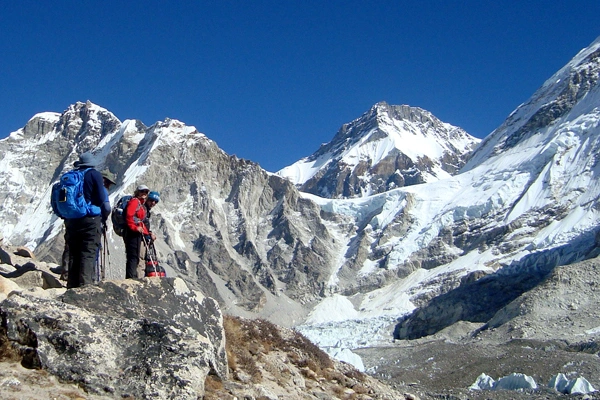- Trek through picturesque villages and terraced farmland,& get a chance to witness the traditional lifestyle of the Gurung & Magar people.
- Follow the Modi Khola River and pass through dense rhododendron forests, where you can spot a variety of wildlife, including the elusive snow leopard.
- Arrive at Annapurna Base Camp (4,130m) and be rewarded with stunning panoramic views of the surrounding peaks, including Annapurna South, Machapuchare (Fishtail), and Hiunchuli.
- Marvel at the majestic sunrise over the Himalayas from Poon Hill (3,210m), a popular vantage point for trekkers.
- Soak in natural hot springs in Jhinu Danda, a perfect way to relax and soothe your muscles after a long day of trekking.
- Enjoy the company of fellow trekkers from all over the world, and immerse yourself in the rich culture and hospitality of the Nepalese people.
Annapurna Base Camp Trek Difficulty: Everything you need to know
Welcome to Nepal Spirit Adventure, today in this article we will discuss "Annapurna Base Camp Trek Difficulty" & how you can prepare for the trek.
Short Overview of Annapurna Base Camp Trek:
Nestled in the heart of the mighty Himalayas lies a trekking adventure that captures the essence of Nepal's natural splendor and cultural richness - the Annapurna Base Camp Trek. Renowned as one of the most popular treks in the world, it beckons adventurers from across the globe to experience the awe-inspiring beauty of the Annapurna Sanctuary.
The Annapurna Base Camp Trek takes you on an unforgettable odyssey through diverse landscapes, from lush rhododendron forests to alpine meadows, and finally to the breathtaking amphitheater of towering peaks that surround the Annapurna massif. This extraordinary journey allows trekkers to immerse themselves in the pristine grandeur of the Annapurna region, where each step reveals new wonders and rewards.
While the allure of this trek lies in its natural and cultural splendor, it is essential to acknowledge the challenges that come along the way. Understanding the Annapurna Base Camp Trek difficulty is crucial for those seeking to embark on this remarkable adventure. This trek falls under the category of moderate to challenging, offering a unique blend of excitement and accomplishment for trekkers of varying experience levels.
The terrain encountered during the Annapurna Base Camp Trek can be demanding, with steep ascents and descents, rugged trails, and occasional sections of moraines. However, with adequate physical preparation and a positive mindset, the trek is accessible to most fit and determined individuals. The rewards of reaching the base camp are immeasurable, making the journey well worth the exertion.
Throughout this blog series, we will delve into the specific aspects that contribute to the Annapurna Base Camp Trek's difficulty. We will explore the elevation gain, altitude considerations, weather conditions, trail conditions, and other factors that make this trek a thrilling adventure and a testament to personal resilience. Whether you are a seasoned trekker or an enthusiastic beginner, this guide will provide valuable insights to help you prepare for the challenges that await you on this extraordinary journey.
Factors Affecting the Annapurna Base Camp Trek Difficulty
Embarking on the Annapurna Base Camp Trek is an exhilarating adventure that requires careful consideration of various factors that contribute to its overall difficulty. Understanding these factors can help trekkers prepare effectively, ensuring a safe and enjoyable journey through the majestic Himalayas. Here are some key elements that influence the Annapurna Base Camp Trek difficulty:
Elevation Gain: The Annapurna Base Camp Trek involves significant elevation gain as you ascend from the starting point to the base camp. Starting from Nayapul, the trail gradually gains altitude, reaching an elevation of 4,130 meters (13,550 feet) at the base camp. The gradual ascent allows for acclimatization but requires a steady pace and physical endurance.
Altitude Considerations: As you ascend higher into the mountains, the thinning air becomes a crucial factor. The Annapurna Base Camp Trek takes trekkers to high altitudes, where the oxygen levels are lower. Acute Mountain Sickness (AMS) can be a concern, so it's important to acclimatize properly, stay hydrated, and be aware of symptoms such as headaches, dizziness, and nausea.
Weather Conditions: Weather plays a significant role in the difficulty of the trek. The Annapurna region experiences diverse weather patterns, with temperatures varying based on the season and altitude. Trekkers should be prepared for cold temperatures, especially at higher elevations, and be aware of the possibility of rain, snow, or strong winds.
Trail Conditions: The trail to Annapurna Base Camp is a mix of well-marked paths, rocky sections, and occasional steep climbs. Some parts of the trail may require crossing suspension bridges or navigating through rugged terrain. Trekkers should be prepared for uneven surfaces, steep ascents, and descents, and be mindful of their footing to ensure safety.
Physical Fitness: The Annapurna Base Camp Trek demands a moderate level of physical fitness. Regular exercise, endurance training, and cardiovascular workouts are beneficial for preparing the body to withstand the challenges of the trek. Strengthening leg muscles and improving stamina will contribute to a more comfortable and enjoyable experience.
Duration and Daily Hiking Distances: The trek's duration and daily hiking distances can impact the difficulty level. The Annapurna Base Camp Trek typically takes around 10-12 days to complete, covering an average distance of 115 kilometers (71 miles). This requires consistent walking for several hours each day, with some days involving longer distances and more challenging terrain.
By considering these factors and adequately preparing for the challenges they pose, trekkers can enhance their chances of a successful and rewarding Annapurna Base Camp Trek experience. Physical training, acclimatization, appropriate gear, and a positive mindset are key elements in overcoming the difficulty and relishing the breathtaking beauty of the Annapurna region.
Hiring a Guide and Porter to ease the Annapurna Base Camp Trek
Hiring a guide and porter for the Annapurna Base Camp Trek provides numerous advantages, including safety, convenience, cultural enrichment, and physical relief. It allows you to focus on the stunning landscapes, immerse yourself in the local culture, and create lasting memories while ensuring a smoother and more enjoyable trekking experience. Consider the benefits of this support system as you plan your adventure in the magnificent Annapurna region.
To enhance the overall experience and ease the challenges along the way, many trekkers opt to hire a guide and porter. Here are some reasons why hiring a guide and porter can be beneficial for the Annapurna Base Camp Trek:
- Local Expertise and Navigation
- Cultural Insight and Language Assistance
- Safety and Emergency Support
- Assistance with Logistics
- Porter Support and Lightened Load
Tips to Reduce Annapurna Base Camp Trek Difficulties
While the Annapurna Base Camp Trek presents its fair share of challenges, there are several ways to mitigate the difficulties and make the journey more manageable and enjoyable. Here are some strategies to reduce the challenges associated with the trek:
- Focus on physical fitness and endurance training.
- Plan for gradual acclimatization to higher altitudes.
- Stay hydrated and maintain a balanced diet for energy.
- Invest in appropriate trekking gear and clothing.
- Use trekking poles for stability and reduced joint strain.
- Maintain a slow and steady pace throughout the trek.
- Prepare mentally with a positive mindset and goal-oriented attitude.
Common Questions about the Annapurna Base Camp Trek Difficulty
Is altitude sickness a concern during the trek?
Yes, altitude sickness, also known as Acute Mountain Sickness (AMS), is a concern during the Annapurna Base Camp Trek. It is important to acclimatize properly, stay hydrated, and be aware of symptoms such as headaches, dizziness, and nausea. Gradual ascent and proper rest days help reduce the risk of AMS.
Is hiring a guide and porter recommended?
Hiring a guide and porter is a personal choice. While it is not mandatory, many trekkers opt to hire them to enhance the trekking experience. Guides provide local expertise, navigation assistance, and cultural insights. Porters can lighten the load and make the trek physically easier. They can also provide safety support in case of emergencies.




